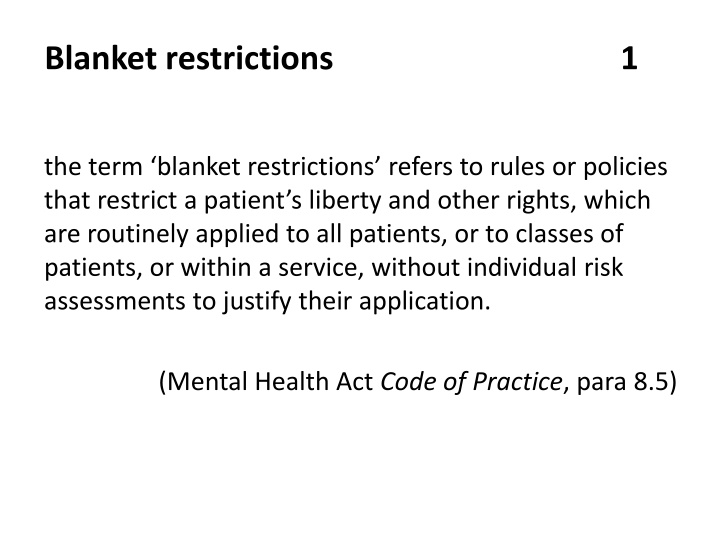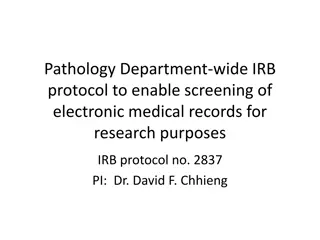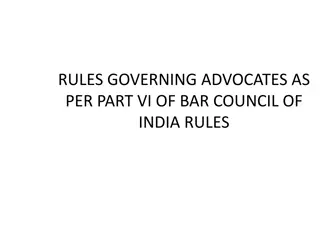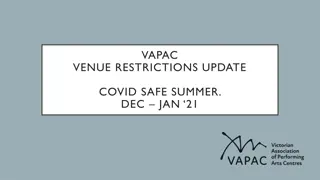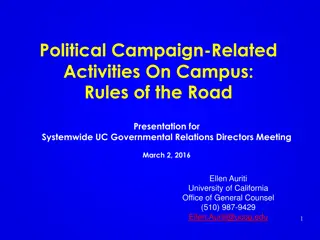Blanket restrictions 1
Blanket restrictions refer to rules or policies that limit a patient's liberty and rights without individual risk assessments. Learn about the impact of smokefree policies in mental health care services and the considerations involved in implementing such restrictions.
Download Presentation

Please find below an Image/Link to download the presentation.
The content on the website is provided AS IS for your information and personal use only. It may not be sold, licensed, or shared on other websites without obtaining consent from the author.If you encounter any issues during the download, it is possible that the publisher has removed the file from their server.
You are allowed to download the files provided on this website for personal or commercial use, subject to the condition that they are used lawfully. All files are the property of their respective owners.
The content on the website is provided AS IS for your information and personal use only. It may not be sold, licensed, or shared on other websites without obtaining consent from the author.
E N D
Presentation Transcript
Blanket restrictions 1 the term blanket restrictions refers to rules or policies that restrict a patient s liberty and other rights, which are routinely applied to all patients, or to classes of patients, or within a service, without individual risk assessments to justify their application. (Mental Health Act Code of Practice, para 8.5)
Blanket restrictions 3 Restrictions that apply to all patients in a particular setting (blanket or global restrictions) should be avoided. There may be settings where there will be restrictions on all patients that are necessary for their safety or for that of others. Any such restrictions should have a clear justification for the particular hospital, group or ward to which they apply. (Mental Health Act Code of Practice, para 1.6)
Mental health care providers have a duty of care to protect the health of, and promote healthy behaviour among, people who use, or work in, their services. This includes providing effective support to stop smoking or to temporarily abstain from smoking while using or working in secondary care inpatient services . Services are increasingly mandated by their commissioning authorities to implement comprehensive smokefree policies, where smoking is banned within the whole hospital estate and tobacco dependence treatment pathways are integral to service provision. Smokefree policies might be perceived as contentious, particularly in services where there is a lack of support to effectively manage nicotine withdrawal and provide a range of alternative activities. However, in response to legal challenges, the Court of Appeal has ruled that smokefree policies do not infringe human rights.
CQC inspections should not challenge smokefree policies, including bans on tobacco smoking in mental health inpatient services (for example, by raising such policies as a unwarranted blanket restriction ). Instead, focus should be paid on whether such a ban is mitigated by adequate advice and support for smokers to stop or temporarily abstain from smoking with the assistance of behavioural support, and a range of stop smoking medicines and/or e-cigarettes. Inspections should also consider whether alternative activities are in place and promoted, including regular access to outside areas.
Reporting The fact that a service is smokefree should not itself be raised as a concern about blanket restrictions . Blanket bans on e-cigarettes that have no cogent justification could, however, be raised as blanket restrictions. Where services have implemented smokefree policies without tobacco dependence training for staff, access to smoking cessation support (i.e.nicotine replacement therapy (NRT), varenicline and/or e-cigarettes), this should be discussed under the effective section of the report. Appropriate medication reviews and monitoring should be completed to ensure that medicines doses are altered when necessary, as smoking status changes. This should be discussed under the safe section of the report.
POLICY Was the smokefree policy, developed in collaboration with staff and people who use secondary care services, or their representatives? Are all staff aware of the smokefree policy and do they comply with it? Are all staff provided with information about the smokefree policy and instructions about their roles and responsibilities in maintaining a smokefree work environment? Does the organisation provide everyone with verbal and written information and advice about the smokefree policy before their appointment, procedure or hospital stay? 1 2 3 4
TRAINING Is there a requirement that all staff are trained to deliver advice on stopping smoking and to make a referral to intensive support? Are all frontline staff trained to deliver advice around stopping smoking and referral to intensive support? They should know what local and hospital-based stop smoking services offer and how to refer people to them. Are all frontline staff trained to talk to people in a sensitive manner about the risks of smoking and benefits of stopping? Are all staff who deliver intensive stop smoking support trained to the minimum standard described by the NCSCT, with additional training that is relevant to their clinical specialism? 5 6 7 8
SUPPORTING SERVICE USERS During the first face-to-face contact, do staff ask everyone if they smoke or have recently stopped smoking and record smoking status and the date they stopped, if applicable, in the person s records (preferably computer-based) and any hand-held notes? 10 Before a planned or likely admission, do staff work with the person to include the management of smoking on admission or entry to the secondary care setting in their personal care plan? 11 Does the trust encourage everyone who smokes to stop smoking completely and if necessary provide immediate access to NRT or other pharmacotherapies when appropriate? 12 Do staff offer and, if the person agrees, arrange for them to receive intensive behavioural support, either during their current outpatient visit or during their inpatient stay? 13 Do staff encourage the use of NRT for anyone who does not want, is not ready or is unable to stop completely? 9
14 Do staff ensure that people who use drugs that are affected by smoking (or stopping smoking) are monitored, and the dosage adjusted if appropriate? Stopping smoking can reduce metabolism of several psychotropic medicines resulting in higher, sometimes toxic blood levels over a few days. This applies in particular to clozapine and olanzapine, two commonly used antipsychotic medications Clinical guidelines recommend reducing doses of these drugs and monitoring blood levels before and at weekly intervals after stopping smoking until levels have stabilised. Services should be mindful of potential consequences to medication plasma-levels should patients resume smoking upon discharge, or smoke heavily when given off-site leave. 15 When people are discharged from hospital, do staff ensure they have sufficient stop smoking pharmacotherapy to last at least 1 week or until their next contact with a stop smoking service?
SUPPORTING STAFF 16 Does the service advise all staff who smoke to stop? Offer staff in- house stop smoking support? Provide contact details for community support if preferred? Allow staff to attend stop smoking services during working hours without loss of pay? 17 Does the service support staff who do not want, or are not ready or able to stop completely to use licensed nicotine-containing products to help them abstain during working hours? 18 Does the service offer and provide intensive behavioural support to maintain abstinence from smoking during working hours?
ENVIRONMENT Are all stop smoking pharmacotherapies included in secondary care formularies? Does the hospital pharmacy stock varenicline, bupropion and a full range of NRT (including transdermal patches and a range of fast-acting products) for patients and staff? Do all hospitals have an on-site stop smoking service? Is a range of NRT available for sale in hospital to visitors and staff? 19 20 21 22
Is use of e-cigarettes included as a component of a strategy to help people quit or cut down? If not, why not, and does the policy reflect NCSCT guidance on e-cigarettes (http://www.ncsct.co.uk/usr/pdf/Electronic%20cigarettes.%20A%20briefing%20for%20stop%20smoking%20services. pdf)? E-cigarettes should not routinely be treated in the same way as smoking. It is not appropriate to prohibit e-cigarette use in health services as part of smokefree policies (see policy position in above brief guide). 23 Some e-cigarette devices contain heating elements and batteries that may pose risks on mental health wards, CQC will expect services to explore individual risk assessment and the use of alternative models of e-cigarette to mitigate these, rather than a blanket ban on the use of e-cigarettes. There is, for example, an e- cigarette model approved for use in prisons. There is increasing flexibility in the ways in which some services are responding to e-cigarette technologies as a way of managing smokefree services. For example, some mental health services have allowed that patients may use electronic cigarettes in certain indoor spaces (such as patients own bedrooms).
SYSTEMS 24 Are discussions and decisions related to stop smoking advice, referrals or interventions recorded in the person s records (preferably computer-based)? 25 Are systems in place to alert the person s healthcare providers and prescribers to changes in smoking behaviour because other drug doses may need adjusting? 26 Is a robust system in place (preferably electronic) to ensure continuity of care between secondary care and local stop smoking services for people moving in and out of secondary care?
RISKS AND MITIGATION OF RISKS 27 What risks have been identified in relation to the smokefree policy, and how have these been mitigated? Especially in acute services, are patients informed of the policy before admission, and do staff consider whether this is having any effect on patients willingness to be admitted? For all services, are the rules associated with the smokefree status fully explained to patients, including the ward policy in relation to the retention (or destruction) of smoking materials that patients might have on them on admission, or on return from leave (see 28 below).
Check whether the smokefree policy (or any safety issue arising from surreptitious smoking) is being enforced by searches, and if so how the service is ensuring proportionality in such security measures. In general terms, searching people on a health promotion premise is unlikely to be appropriate, but searching may be a proportionate response to risks associated with cigarette lighters etc. Likely problems in the implementation of the smokefree policy include fire-risks through surreptitious smoking, or the risk of exploitation of vulnerable patients as a result of illicit markets in smoking materials. Services should have identified any patient at risk of exploitation and sought to counter this. Services that provide access to NRT or e-cigarettes may be less likely to experience illicit markets in smoking materials.
28 How do services manage patients who return from leave with cigarettes in their possession? The smokefree policy should clearly state how staff should respond when patients bring smoking materials into a smokefree environment. These arrangements should be clearly communicated to people who use services. Services are likely to require patients to hand over any smoking materials. Some services will return these when that patient is next leaving the hospital site. Others only return confiscated smoking materials upon eventual discharge,which could be challenged under the MHA Code of Practice principle of least restriction. Other services have reported destroying any confiscated smoking products, which may also raise questions of legal authority to do so. 29 In acute services, do staff report any changes in admission patterns that may be linked to the smoking ban for example, do patients refuse informal admission?
